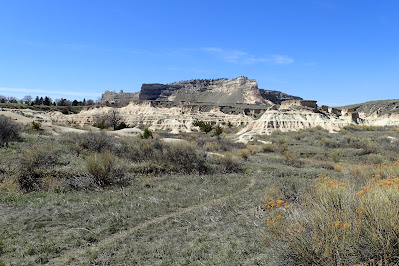Yesterday, I had arranged and led a small group cleanup of the badlands area of Scotts Bluff National Monument. It is a small area of erosional features that contains a wealth of paleontological resources. Despite the windy conditions, we managed to clean up a fairly large portion of the badlands.
Having my interest in the badlands renewed, I decided today would be a good day to do some exploring in that part of the monument with Noelle and Sierra. We made the short drive to the gate, parked off to the side of the road and started our hike on the canal road. We followed the fence marking the eastern boundary of this part of the monument and then started to make our way into the erosional features to explore.
Where we entered into the badlands, we were practically at the railroad tracks that bisect the northern part of the monument. A look back towards Scotts Bluff offered wonderful views of the bluff itself, and the interesting erosional formations.
As we explored the area near the railroad tracks we found a few areas of fossils.
Most appeared to be turtles, which are very common in this area. Likely stylemys nebrascensis. I also found pieces of what appeared to be fossilized beaver teeth.
They had a dark section that appeared to be the iron rich enamel that beaver teeth are known for.
As we roughly followed the railroad tracks west, we made our way into a small canyon and then climbed a ridge up and then down into a different canyon system. This part of the badlands appears to get much less foot traffic than the section where most people enter at the east end of the canal road. Almost immediately, the scenery seemed a little bit more dramatic.
We found some really large bones. They weren't fossilized, but looked to be from bison or cattle.
They seemed to be badly weathered, giving the impression that they belonged to an animal that died long ago. We started to make our way up this canyon system, admiring the views along the way.




















































